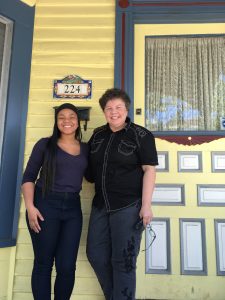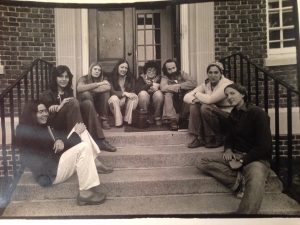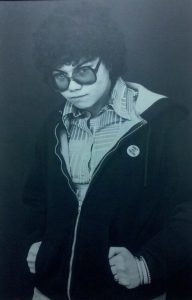Who needs an intro when I can simply say one word: Lesbian. Yes, I said it. This is about Rue Watson, a lesbian student who graduated Douglass College in 1977. Her experience at Douglass from the point of view of a lesbian student is important and critical to the identity development of the modern day lesbian students at Rutgers. This interview, which was condensed and edited, was conducted by Camille DuBois (RU ’19), as a component of the Public History Internship during summer 2018. The interview took place at a house in New Brunswick.

Could you tell us where we are now and where are you from?
I owned and lived in this house since 1982. This house was home and social place for many of the New Brunswick Gay and Lesbian community members, and over the years, lots of people lived here. I was a DJ and in that role with music and dancing being a MAJOR social aspect of the Lesbian and Gay Community in that era. Dance parties and dance clubs were the primary places people relied upon for socializing, networking, along with the dissemination of pertinent information. My role promoting and throwing events for dances and parties is why I had the privilege to know so many people and to be involved in so much of the community activities.
My family was from Washington DC where I lived until I was twelve years old. My parents were looking for a summer home in Wildwood, New Jersey near Cape May. But during the sixties nobody would sell a house in Wildwood to Blacks. My parents learned from the realtor that many Blacks lived in McKee City, and they could buy a house there. We gave up on Wildwood and headed to McKee City, which is fifteen miles inland from Atlantic City. Many Blacks lived on the other side of the train tracks, but my mother refused to join them. After purchasing a bungalow on the right side of the train tracks, my father bought the chicken farm across the street, where I lived before attending Douglass.
What was your major at Douglass College?

My major was American Studies and I sort of minored in art, with a focus on photography. I was really into photography and enjoyed taking pictures all the time. I thought it was wonderful. I also thought American Studies was a great major. Professor David Burrows, from English Department, was great and open to students of all sexualities. Professor Burrows taught a Photo Essay course in which the students in pairs took photos of each other and wrote an essay or a poem about each other. I loved it! He had a professional photo studio in Princeton. With his encouragement and guidance, I took many pictures of campus events and people. His class was certainly a safe place for lesbians.
Were you aware of the Student Homophile League at Rutgers?
Yes, once I was at Douglass, I was affiliated with the Gay Alliance, which later became Gay and Lesbian Alliance. If something good and fun in terms of social event was happening organized by the Alliance, everyone would attend the event. In addition to social events, the Alliance did outreach to different communities to increase understanding and to end discrimination of gays and lesbians. I did volunteer for a few sessions. I got the courage to participate in the outreach to the State Troopers. We lesbian students wore dresses and tried to look feminine just like your next-door neighbor girl. We felt that it was important to show the troopers that we were ordinary and not threatening. My dad was a policeman, and I was comfortable with law enforcement officers. I wanted to help them understand that we were pretty normal people.
What effect did Stonewall have on you?
I think it was major impact for me because I found my community at the university. Coming to Rutgers not long after Stonewall, people were energized from it and established the Homophile League. I came to Douglass just by luck. The girl I was in love with in high school was coming to Douglass, which prompted me to apply. No one in my family had gone to college, so I knew nothing about college. If this girl had gone to a typing school, I would have followed her there. It was just the luck of the draw. I was following her around like a little puppy when I first came to Douglass. After the first three months at Douglass we grew apart and didn’t see much of each other. I found “my people.” She was into fraternities and was looking for a boyfriend.
How did your family take it when you came out to them?
I came out in high school during “The Supremes” concert at Chez Paree on New York Avenue in Atlantic City. My friend R had invited me to go with him to the concert. I was impressed and excited about this! The show started and these women who looked like “The Supremes” were singing. There was something quite different about this Supremes group…as it turns out, they were drag queens and they were incredible! I had never seen anything like that! R looks at me and goes” I’m gay” and I look at him and I go “me too.” That is when I came out. R and I are still friends to this day.
When I came out, it was hard at first with my family. My mother said “you’ll be better off dead” and we didn’t talk for a while, maybe almost a year. But the reason why I have this house is because after they accepted my sexuality, they said “you are never going to have a husband and we need to get you a house so that you have a roof over your head.”
What kind of LGBTQ reading material was out there at the time you were in college?
I can’t explain it and don’t know how exactly it happened, but I was reading The Second Sex by Simone de Beauvoir in high school. It might have been a suggestion from my high school English teacher Ms. M, and she might have given it to me. Otherwise I am not sure how an African-American girl living in the countryside on a farm came by this book, but I read it and it was so informative. It helped me understand the fact that I was a woman, gay and Black, and I had to form my own identity. There were so many negative opinions about Black people and most likely many people held negative opinions about gay people. I knew I was not a bad person and the gay people I knew were not bad either, so I pulled all that together. And reflecting on that book, I carved out an ideology that the powers that be, men in power especially, want to have you think negatively about women, and anyone who they deem to be different a threat. I was a good person, and as a woman, and Black and now a gay person. I was not going to be oppressed by or buy into the negative stereotypes that were being framed for me to take on. The book had a great impact on me.

I came to Rutgers in the summer of 1973, before college, as an EOF student to take classes in math. I lived in one of the river dorms on College Avenue Campus before moving to Douglass Campus. I went to Alexander Library and searched for “homosexuality” in the card catalog and found the name of Rita Mae Brown. I also learned of a place called “Village” in New York with many gays and lesbians. I got on a bus and I went by myself to find the “Village.” Just by chance, I saw in front of a firehouse a sign that Rita Mae Brown along with now famous lesbian couple and activists Del Martin & Phyllis Lyon were doing a reading.
As it turns out the firehouse was a gay center in the Village. Del Martin and Phyllis Lyon were the founders of the organization Daughters of Bilitis and its magazine The Ladder. They also wrote the book Lesbian/Woman which was a staple of every lesbian library. This book provides useful tips for people who came out as a lesbian, on how to host a pot luck dinner for networking and how to receive a copy of Lesbian/woman. It was an amazing day. I had no idea what Rita Mae Brown looked like and had my breath taken away as she did not look like any of the drag queens down on New York Ave in Atlantic City. Rita Mae Brown was quite beautiful! Poised and well dressed. She was also very down to earth and earnest. I introduced myself and we kept in touch.
In the fall, Rita Mae Brown invited me for other events in New York City. She sent me an invitation to the launch of her book Rubyfruit jungle, which was in a loft in the “Village.” I went there with two friends. It was an exciting loft party with distinguished lesbians and cool people that made us feel less isolated and alone. And then Rita Mae gave us a copy of the book and signed it. What an amazing evening to get invited! I look back now and see it as a pivotal literary event—the publishing of one of the most iconic lesbian novels of all time, which became an overnight success with women everywhere of all persuasions. In 1977, Rita Mae Brown came to Douglass as a speaker thanks to the Vorhees Assembly Board [the Douglass Student Organization].